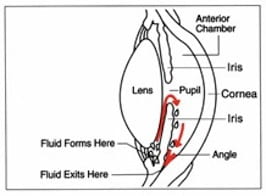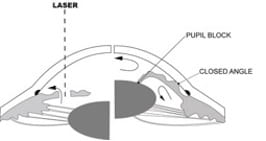In brief, fluid (Aqueous Humor) is constantly produced inside the eye by a certain tissue behind the iris called the Ciliary Body. This fluid flows around the pupil to the front chamber of the eye (the Anterior Chamber) and is drained out of the eye at the 'Angle' (see below).
There are anatomical variations in different peoples' eyes and in some, the origin of the iris is located very close to the drain of the eye at the angle resulting in a 'narrow angle' configuration. Those with narrow angles are at risk of 'angle closure' where this proximity of the iris root to the drain can block access of fluid to the drain, causing a build up of pressure within the eye.
This can then lead to glaucoma by damaging the optic nerve (the nerve that transmits sight signals from the eye to the brain). The process of angle closure can either happen suddenly – resulting in 'acute angle closure' where the pressure within the eye (the intraocular pressure) rises to a dangerously high level in a matter of hours, causing severe pain and loss of vision; or it can happen more insidiously resulting in a slower rise in intraocular pressure without any notable symptoms but still just as damaging to the vision over time if undetected.


This is a laser procedure performed in the clinic. It uses very focused pulses of laser energy to create a hole in the outer edge of the iris. This allows a more direct path for the fluid (aqueous humour) to flow into the front chamber of the eye (see below). It changes the fluid dynamics within the eye, resulting in widening of the angle in most people and significantly reduces the risk of acute angle closure. (Note: the aqueous humour is completely different fluid to your tears. This procedure does not affect the tear drainage or symptoms of 'watery eye').